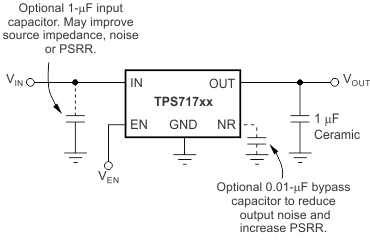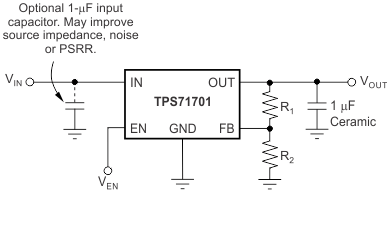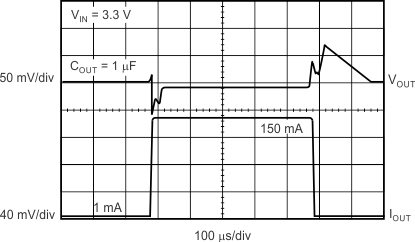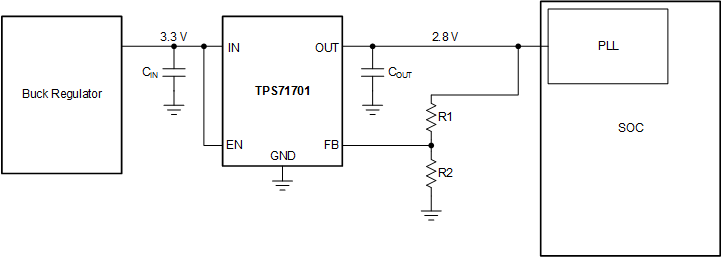ZHCSAL2H February 2006 – January 2015 TPS717
PRODUCTION DATA.
- 1 特性
- 2 应用
- 3 说明
- 4 修订历史记录
- 5 Pin Configuration and Functions
- 6 Specifications
- 7 Detailed Description
- 8 Application and Implementation
- 9 Power Supply Recommendations
- 10Layout
- 11器件和文档支持
- 12机械封装和可订购信息
封装选项
机械数据 (封装 | 引脚)
散热焊盘机械数据 (封装 | 引脚)
- DRV|6
订购信息
8 Application and Implementation
NOTE
Information in the following applications sections is not part of the TI component specification, and TI does not warrant its accuracy or completeness. TI’s customers are responsible for determining suitability of components for their purposes. Customers should validate and test their design implementation to confirm system functionality.
8.1 Application Information
The TPS717xx belongs to a family of new generation LDO regulators that use innovative circuitry to achieve ultra-wide bandwidth and high loop gain, resulting in extremely high PSRR at very low headroom (VIN – VOUT). Fixed voltage versions provide a noise reduction pin to bypass noise generated by the band-gap reference and to improve PSRR while a quick-start circuit fast-charges this capacitor. These features, combined with low noise, enable, low ground pin current, and ultra-small packaging, make this part ideal for automotive applications. This family of regulators offers sub-band-gap output voltages, current limit, and thermal protection, and is fully specified from –40°C to 125°C.
8.1.1 Transient Response
As with any regulator, increasing the size of the output capacitor reduces overshoot or undershoot magnitude but increases duration of the transient. The TPS717xx has an ultra-wide loop bandwidth that allows it to respond quickly to load transient events. As with any regulator, the loop bandwidth is finite and the initial transient voltage peak is controlled by the sizing of the output capacitor. Typically, larger output capacitors reduce the peak while also reducing the bandwidth of the LDO, slowing the response time.
8.1.2 Input and Output Capacitor Requirements
Although an input capacitor is not required for stability, good analog design practice is to connect a 0.1-μF or larger low equivalent series resistance (ESR) capacitor from IN to GND near the regulator. This capacitor counteracts reactive input sources and improves transient response, noise rejection, and ripple rejection. A higher-value capacitor may be necessary if large, fast rise-time load transients are anticipated or if the device is located several inches from the power source. If source impedance is not sufficiently low, a 0.1-μF input capacitor may be necessary to ensure stability.
The TPS717xx is designed to be stable with ceramic output capacitors of values 1 μF or larger. The X5R- and X7R-type capacitors are best because they have minimal variation in value and ESR over temperature. The maximum ESR of the output capacitor must be less than 1 Ω.
8.1.3 Dropout Voltage
The TPS717xx uses a PMOS pass transistor to achieve low dropout. When (VIN – VOUT) is less than the dropout voltage (VDO), the PMOS pass device is in its linear region of operation and the input-to-output resistance is the RDSon of the PMOS pass element. VDO scales approximately with output current because the PMOS device functions as a resistor in dropout.
As with any linear regulator, PSRR and transient response are degraded when (VIN – VOUT) approaches dropout. This effect is illustrated in Figure 15 through Figure 17 in Typical Characteristics.
8.1.4 Output Noise
In most LDOs, the band gap is the dominant noise source. If a noise reduction capacitor (CNR) is used with the TPS717xx, the band gap does not contribute significantly to noise. Instead, noise is dominated by the output resistor divider and the error amplifier input. To minimize noise in a given application, use a 0.01-μF (minimum) noise reduction capacitor; for the adjustable version, smaller value resistors in the output resistor divider reduce noise. A parallel combination that gives 2.5 μA of divider current has the same noise performance as a fixed voltage version.
Equation 2 approximates the total noise referred to the feedback point (FB pin) when CNR = 0.01 μF:

8.2 Typical Applications
8.2.1 Application for Fixed Voltage Versions and Adjustable Voltage Version
Figure 33 shows the basic circuit connections for the fixed voltage options. Figure 34 gives the connections for the adjustable output version (TPS71701). Note that the NR pin is not available on the adjustable version.
 Figure 33. Typical Application Circuit
Figure 33. Typical Application Circuit (Fixed Voltage Versions)
 Figure 34. Typical Application Circuit
Figure 34. Typical Application Circuit (Adjustable Voltage Version)
8.2.1.1 Design Requirements
Table 2 summarizes the design requirements for Figure 36.
Table 2. Design Parameters
| PARAMETER | DESIGN REQUIREMENT |
|---|---|
| Input voltage | 3.3 V, ±10% |
| Output voltage | 2.8 V, ±5% |
| Output current | 100 mA typical, 150 mA peak |
| Output voltage transient deviation | 5% |
| Maximum ambient temperature | 85°C |
8.2.1.2 Detailed Design Procedure
For the adjustable version (TPS71701), the NR pin is replaced with a feedback (FB) pin. The voltage on this pin sets the output voltage and is determined by the values of R1 and R2. The values of R1 and R2 can be calculated for any voltage using the formula given in Equation 3:
The value of R2 directly impacts the operation of the device and must be chosen in the range of approximately
160 kΩ to 320 kΩ. Sample resistor values for common output voltages are shown in Table 3.
Table 3. Sample 1% Resistor Values for Common Output Voltages
| VOUT | R1 | R2 |
|---|---|---|
| 1 | 80.6 kΩ | 324 kΩ |
| 1.2 | 162 kΩ | 324 kΩ |
| 1.5 | 294 kΩ | 332 kΩ |
| 1.8 | 402 kΩ | 324 kΩ |
| 2.5 | 665 kΩ | 316 kΩ |
| 3.3 | 1.02 MΩ | 324 kΩ |
| 5 | 1.74 MΩ | 332 kΩ |
8.2.1.3 Application Curve
 Figure 35. Load Transient Response
Figure 35. Load Transient Response
8.2.2 Powering a PLL Integrated on an SOC
Figure 36 shows the TPS71701 powering a phase-locked loop (PLL) that is integrated into a system-on-a-chip (SOC).
 Figure 36. Typical Application Circuit: PLL on an SOC
Figure 36. Typical Application Circuit: PLL on an SOC
Use the input and output capacitors to ensure the voltage transient requirements. A 1-µF input and 1-µF output capacitor are selected to maximize the capacitance and minimize capacitor size.
R2 is chosen to be 158 kΩ for optimal noise and PSRR, and by Equation 4, R1 is selected to be 402 kΩ. Both R1 and R2 must be 1% tolerance resistors to meet the dc accuracy specification over line, load, and temperature.
8.3 Do's and Don'ts
Do place at least one 1-µF ceramic capacitor as close as possible in the range of the regulator.
Do not place the output capacitor more than 10 mm away from the regulator.
Do not place any components in the feedback loop except for the output capacitor and feedback resistors.
Do not exceed the device absolute maximum ratings.
Do not float the enable (EN) pin.
